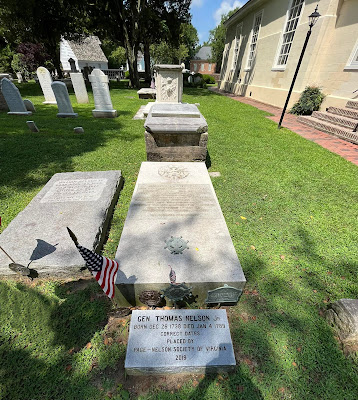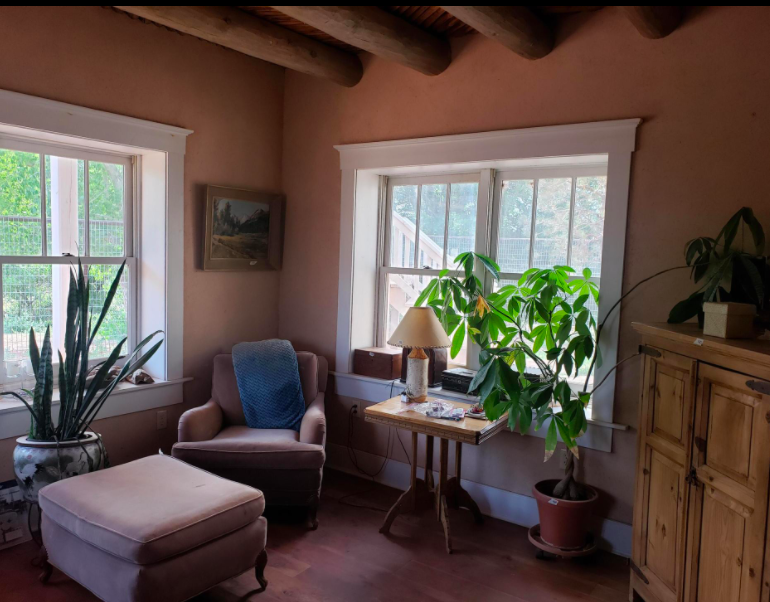In February I posted that I had just recently joined a Facebook group called Dodge, Madrid, Page, Padilla Families - Puerto de Luna, New Mexico
Since then I have come to realize that the families such as the Nelson and Page families of Virginia overlap as much as the families in New Mexico like the Padilla and Fajardo families. Now I have been totally entertained by the fact that the Page and Nelson families of Virginia overlap many times over with my children's Ethridge branch of the family tree. This has lead to hours of reading about the United States' founding families of Virginia. Up to this point I had only been interested in the founding families of New Mexico.
This week my cousin, John Dodge posted that he had just visited his fifth and sixth great grandfathers’ graves in Yorktown Virginia, Thomas Scotch Nelson Senior and his son, Brigadier General Thomas Nelson Jr.
 |
| Photo of Thomas Nelson Grave Taken by John Dodge July 16, 2022 |
 |
| John Dodge July 16, 2022 |
 |
| Lucy Grymes |
Nelson became a planter and an estate manager. When he and his fellow signers pledged “our lives, our fortunes and our sacred honor,” the men of the Second Continental Congress took that risk seriously. He gave his fortune and his health to further the cause of American Independence.
Thomas Nelson Jr. wasn't a healthy man and the mission of independence took a lot out of him resulting in an early death at the age of 50. He also donate all of his money it to help win the War of Independence.
He was elected to Virginia’s House of Burgesses and was a very outspoken opponent of Britain and their policies toward the colonies and was one of the first leaders in the colonies to entertain the idea of an independency for the colonies. He believed that it was absurd to have the colonists hold an “affection for a people who are carrying on the most savage war against us.” On November 7, 1774, Nelson was a member of the Yorktown Tea Party. Citizens of York County, Virginia had passed a non-importation boycott in response to the Tea Act of 1773. When the British ship Virginia docked at Yorktown, enraged citizens marched onto the ship and dumped two imported half-chests of tea into the water. The boycott was an effort to pressure the British Parliament to repeal tax laws and regulations.
Nelson was appointed as a member of the Second Continental Congress in mid-1775, replacing George Washington when Washington left the Congress to go to Boston to take command of the Continental Army. He had returned to Virginia and was in Williamsburg on May 15, 1776 when the Fifth Virginia Convention passed a series of resolutions declaring Virginia was no longer a part of the British Empire. Nelson immediately carried the news from Virginia to Philadelphia where Richard Henry Lee on June 6, 1776 made the official resolution for independence within the Second Continental Congress, that would lead to the Declaration of Independence. He eventually had to resign from the Congress due to poor health.
Nelson was later appointed a brigadier general in the Continental Army and commanded the Virginia militia during the battle of Yorktown in 1781 during the American Revolutionary War. It was here that one of the most selfless acts of his life took place as he ordered the artillery of the Continental Army to fire on his home, where several British officers were headquartered. The home was heavily damaged. The surrender of the British troops at Yorktown occurred soon after.
In June of 1781, Nelson became the second governor of Virginia, succeeding Thomas Jefferson. He had to resign in November of 1781 due to poor health. By this point in his life, he had lost almost everything. His businesses were destroyed. He was owed over two million dollars by the United States government for his loans to help finance the French fleet and their aid to the war effort. He was never repaid and his financial well-being was destroyed.
Nelson passed away at his home at the age of 50 in 1789 due to severe asthma. His body was originally buried in an unmarked grave in Yorktown because of a fear that creditors may hold his body for collateral until his debts were paid. He now rests under a beautiful stone that pays tribute to him and his service to the United States, including honoring his service as a signer of the Declaration of Independence.




















